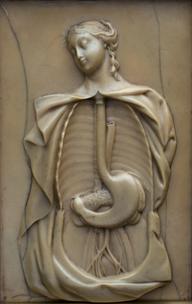





Polyptome in leather bound case, Aveling's, 19th century, plated steel, ebony, case brass, leather and velvet
A polyptome treated tumours or fibroids (non-cancerous growths) within women’s reproductive organs. The tool was also known as a polypus knife. The metal hook-like object with serrated inner edge inserted into the body and removed the growth.
Details
- Category:
- Obstetrics, Gynaecology & Contraception
- Collection:
- Sir Henry Wellcome's Museum Collection
- Object Number:
- A615371
- Materials:
- instrument, steel (plated), instrument, ebony, case, brass, case, leather and case, velvet
- Measurements:
-
overall: 30 mm x 272 mm x 44 mm, .103kg
instrument: 20 mm x 255 mm
- type:
- obstetric polyptome




